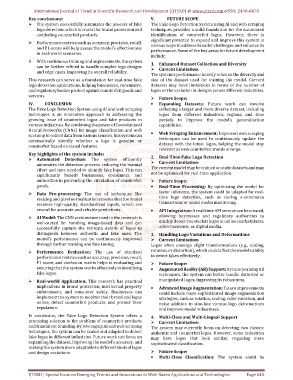Page 650 - Emerging Trends and Innovations in Web-Based Applications and Technologies
P. 650
International Journal of Trend in Scientific Research and Development (IJTSRD) @ www.ijtsrd.com eISSN: 2456-6470
Key conclusions: V. FUTURE SCOPE
The system successfully automates the process of fake The Fake Logo Detection System using AI and web scraping
logo detection, which is crucial for brand protection and techniques provides a solid foundation for the automated
combating counterfeit products. identification of counterfeit logos. However, there is
significant potential to expand and improve this system in
Performance metrics such as accuracy, precision, recall,
various ways to address broader challenges and enhance its
and F1-score will help assess the model's effectiveness
performance. Some of the key areas for future development
in real-world scenarios.
include:
With continuous training and improvements, the system 1. Enhanced Dataset Collection and Diversity
can be further refined to handle complex logo designs Current Limitation:
and edge cases, improving its overall reliability.
The system’s performance heavily relies on the diversity and
This research can serve as a foundation for real-time fake size of the dataset used for training the model. Current
logo detection applications, helping businesses, consumers, datasets may have limitations in terms of the number of
and regulatory bodies protect against counterfeit goods and logos or the variation in designs across different industries.
services.
Future Scope:
IV. CONCLUSION · Expanding Datasets: Future work can involve
The Fake Logo Detection System using AI and web scraping collecting a larger and more diverse dataset, including
techniques is an innovative approach to addressing the logos from different industries, regions, and time
growing issue of counterfeit logos and fake products in periods to improve the model’s generalization
various industries. By combining the power of Convolutional capabilities.
Neural Networks (CNNs) for image classification and web ·
scraping to collect data from various sources, this system can Web Scraping Enhancement: Improved web scraping
techniques can be used to continuously update the
automatically identify whether a logo is genuine or
dataset with the latest logos, helping the model stay
counterfeit based on visual features.
relevant as new counterfeit trends emerge.
Key highlights of the system include:
2. Real-Time Fake Logo Detection
Automated Detection: The system efficiently
Current Limitation:
automates the detection process, reducing the manual
The current model may be trained on static datasets and may
effort and time needed to identify fake logos. This can
not be optimized for real-time application.
significantly benefit businesses, consumers, and
authorities in preventing the circulation of counterfeit Future Scope:
goods. · Real-Time Processing: By optimizing the model for
faster inference, the system could be adapted for real-
Data Pre-processing: The use of techniques like
resizing and pixel normalization ensures that the model time logo detection, such as during e-commerce
receives high-quality, standardized inputs, which are transactions or social media monitoring.
crucial for accurate and reliable predictions. · API Integration: A real-time API service can be created,
allowing businesses and regulatory authorities to
AI Model: The CNN architecture used in the research is
well-suited for handling image-based data and can quickly detect counterfeit logos in online marketplaces,
successfully capture the intricate details of logos to advertisements, or digital media.
distinguish between authentic and fake ones. The 3. Handling Logo Variations and Deformations
model’s performance can be continuously improved Current Limitation:
through further training and fine-tuning. Logos often undergo slight transformations (e.g., scaling,
rotation, or distortion), which could affect the model’s ability
Performance Evaluation: The use of standard
to detect fakes effectively.
performance metrics such as accuracy, precision, recall,
F1-score, and confusion matrix helps in evaluating and Future Scope:
ensuring that the system works effectively in identifying · Augmented Reality (AR) Support: By incorporating AR
fake logos. techniques, the system can better handle distorted or
manipulated logos, improving its robustness.
Real-world Application: This research has practical
implications in brand protection, intellectual property · Advanced Image Augmentation: Future improvements
enforcement, and consumer safety. Businesses can could include more sophisticated image augmentation
implement the system to monitor their brand and logos strategies, such as rotation, scaling, color variation, and
online, detect counterfeit products, and protect their noise addition to simulate various logo deformations
reputation. and improve model robustness.
In conclusion, the Fake Logo Detection System offers a 4. Multi-Class and Multi-Lingual Support
promising solution to the problem of counterfeit products Current Limitation:
and fraudulent branding. By leveraging AI and web scraping The system may currently focus on detecting two classes:
techniques, the system can be scaled and adapted to detect authentic and counterfeit logos. However, some industries
fake logos in different industries. Future work can focus on may have logos that look similar, requiring more
expanding the dataset, improving the model’s accuracy, and sophisticated classification.
making the system more adaptable to different kinds of logos
and design variations. Future Scope:
· Multi-Class Classification: The system could be
IJTSRD | Special Issue on Emerging Trends and Innovations in Web-Based Applications and Technologies Page 640

